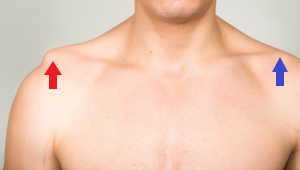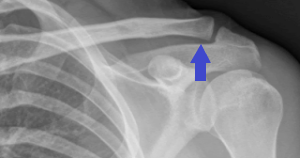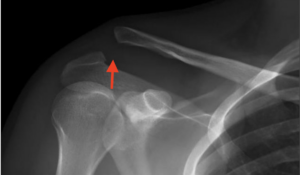Acromioclavicular (AC) Joint Sprain/ Shoulder Separation
What is an Acromioclavicular (AC) Joint Separation?
An AC joint sprain and a separated shoulder are the same thing. This is different than a dislocated shoulder.
A separated shoulder is when the ligament connection between the collar bone and the shoulder blade becomes injured. This is also called a sprain. (see photo normal and sprain labeled with arrows).
There are three basic types of AC Joint Sprains: Grade 1, Grade 2 and Grade 3. A grade 3 is the worst and a grade 1 is the least severe. (Officially there are at least 6 different types, but Grades 4, 5 and 6 are all just variation of a Grade 3 sprain).
What causes an Acromioclavicular (AC) Joint Separation?
AC Joint Sprains happen from trauma such as an accident or a fall or in sports. Usually the person strikes the ground right on their shoulder.
What are the symptoms of an Acromioclavicular (AC) Joint Separation?
The person feels immediate pain on the top of their shoulder. For Grade 1 injuries the shoulder will look normal. For Grade 2 injuries there will be a small bump over the top of their shoulder. For Grade 3 injuries there will be a large bump over the top of their shoulder (see picture).
How to find out if you have an Acromioclavicular (AC) Joint Separation?
Both a physical exam and X-rays are needed to diagnose an AC Joint Sprain. An MRI can be helpful in older people to look for other injuries.
How is an Acromioclavicular (AC) Joint Separation treated?
Treatment for a grade 1 and 2 is no surgery. The person is placed in a sling. The sling is used as needed only. If the person does not want to wear the sling they do not have to. Healing takes 6 weeks. As the person’s pain lessens they can begin to use their arm as tolerated. The person should listen to their pain and they should avoid activities that could cause a second injury to the shoulder. Most of the time the shoulder function returns to normal.
Type 3 injuries can be treated with no surgery or with surgery depending on the person’s wishes. There are advantages to both.
Treatment without surgery is exactly the same as treatment for a grade 1 and 2 above. The advantage of no surgery is that there is no surgery, no scar, and the patient can use their arm earlier than with surgery. The disadvantage with no surgery is that the shoulder will always have a “lump” and the shoulder will always look “downward” compared to the other shoulder (see picture). Also, some patients will have shoulder problems such as pain and/or weakness. However, most of the time the shoulder function returns to normal.
The advantage of surgery to fix the grade 3 separation is that the shoulder can look and feel normal again. The disadvantage is that it requires 2 surgeries: one to fix the separation and a second to remove the screw at the 6 week mark. Surgery also requires the person use a sling and to limit the use of their shoulder for 6 weeks. Most of the time, the shoulder function returns to normal.

The collar bone is up (red arrow)
The collar bone is normal (blue arrow)

Normal shoulder
